Today, a business nearly can’t function and do its marketing without a fast-performing and up-to-date mobile application. This is because in our digitally driven world, having this solution largely extends your reach and seamlessly connects you with your audience. Furthermore, having technology assistance and various tools at their side at any time increases your staff’s productivity. Commencing the development requires careful consideration of its costs, quality, and speed. In this rundown, we’ll touch upon the topic of application development costs. Discover the factors that play a significant role in determining these costs and find the response to the fundamental inquiry: ‘How much does it cost to develop an application?’
What is the average cost of application development?
Engineering an application is like erecting a modular house. Every segment has its costs, and altogether they form the ultimate amount that one needs to disburse on the entire construction. Likewise, an application has its array of characteristics, belongs to a certain type that defines its complexity, is competitive with selected OSs, can be a final solution or a prototype, and be programmed by an onshore or offshore application development firm.
Long story short, the custom app development cost can fluctuate from a few thousand to several hundred thousand US dollars, influenced by the interplay of the abovementioned considerations. Therefore, let us explain each of them in more detail.
What application parameters hold sway on the development costs?
Below are the four principal parameters that our development experts regard as crucial in gauging the mobile application development cost.
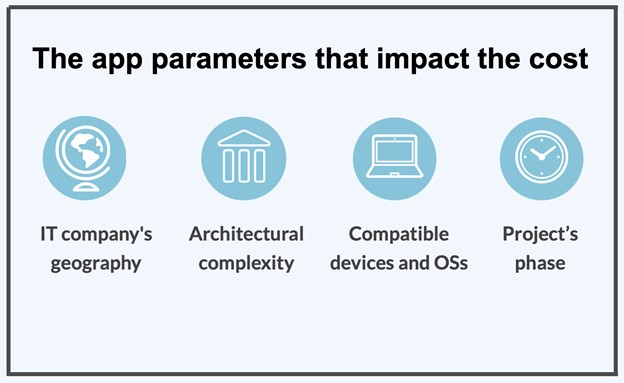
The geography of your development partner
In our post-pandemic and extremely uncertain reality, operating from any location has become a new norm. The teams can be assembled of well-versed specialists located in any country. The hourly rates they command are impacted by their geographies. Accordingly, the custom mobile app development pricing is fluctuating.
In the US, according to fresh insights from Salary.com, the hourly remuneration for a proficient specialist lies between $37 and $62 judging from their proficiency, expectations, and qualification.
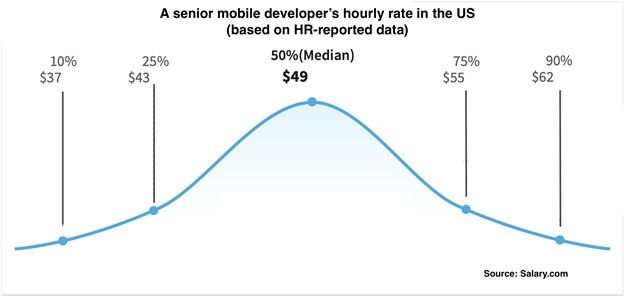
Such a reputable source as Clutch claims that the figure is higher for a development firm in this region and can reach $149 by the hour. On the contrary, the vendors that establish their headquarters in countries like Ukraine or Poland charge much less for the identical scope of services. Namely, their application development costs can go up to $25 by the hour.
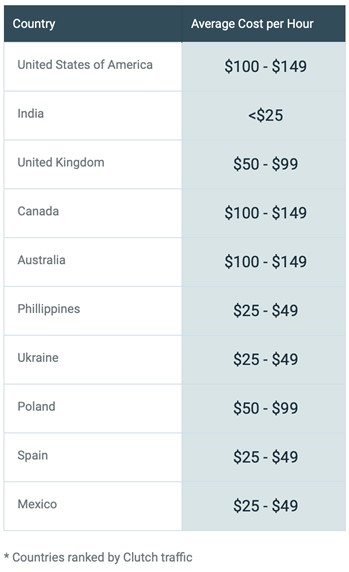
Thus, the average cost of application development largely rests on its timeframes and employee geography. The timeframes, in turn, hinge on the intricacy of the solution, the area of its intended use, and its characteristics.
The area of use and architectural complexity
It’s no secret that delivering a directory or a static content application is more streamlined and thus, cost-effective than engineering a convoluted enterprise-grade healthcare or finance product. Correspondingly, the average cost of mobile application development in the latter case will increase since working on the advanced design and configurations necessitates additional resources.
Upgrading a product with cutting-edge capabilities, e.g. multi-factor authentication, secure data transmission, API interconnectivity, the ability to handle multiple users and an extensive screen system, IoT device pairing, etc. necessitates a good amount of time and thus, sizable investments in the IT initiative.
The range of compatible devices and OSs
To gain a clarification to the puzzle ‘How much does it cost to create an application?’, the necessary condition is to figure out what devices and OSs it’s intended for. It’s common knowledge that software for Android and iOS, the prevalent OSs, is coded with the use of disparate technology stacks. While the former entails the mastery of Java and the Android SDK, the latter necessitates coding in Swift or Objective-C programming languages and familiarity with iOS SDK.
According to the preceding, as the platform diversity grows, the development becomes increasingly time-consuming and cost-demanding. An ideal option is to employ React Native, Ionic, or other prevalent frameworks for envisioning a multi-platform program. In this case, you won’t devote extra efforts to devising two separate tailored-fit front-ends and testing and maintaining several custom products.
Project’s phase and its overall completeness
Last but not least, the mobile application development cost hikes in proportion to app completeness. The further you proceed along the development lifecycle, the pricier the final result is. The rationale for this is that the architecture gets overly convoluted, the design immensely elaborate, and there is an exceeding number of integrations with external programs.
Meanwhile, pursuing an MVP, a stage that can, in fact, be omitted, can substantially lower application development costs. This is because it allows you to spot inconsistencies in the product and revise it in a timely manner, or else completely abandon the notion of continuing with it.
What additional costs should you weigh up?
When turning to a candidate vendor for a custom system and wanting to elicit an explanation to the doubt: ‘How much does it cost?’, you should be aware that there are some surplus costs that can occur throughout your undertaking. A truly reliable vendor will, without a doubt, explain them to you in advance.
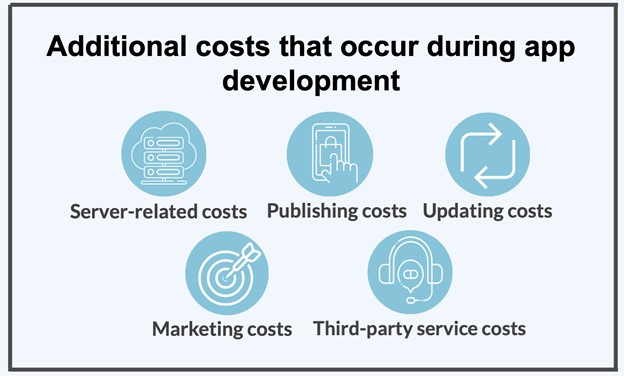
Server-related costs
These are in direct proportion to the nature of the proffered services, the scope of your viewership, and the volumes of data conveyance. For instance, social media or eLearning software with voluminous multimedia content will definitely require substantial space to store it.
The dominant providers are Amazon AWS, Microsoft Azure, and Google Cloud. They offer diverse subscription varieties that are normally purchased on a monthly basis and are aligned with your demands.
Publishing costs
In order to publicize your solution, a fee is charged for a developer account. Google charges a lump sum payment of $25, while Apple imposes a yearly fee of $99 and supplementary charges for app-based transactions. Of course, these sums are insignificant. Despite this, you should take note of them also. if you’re contemplating rolling out your offer via these stores.
Updating and upkeep costs
How much does it cost to perpetually upkeep and upgrade the software to keep it on top of its performance? It’s believed that these costs typically reach 15-20% of the total IT initiative’s budget. However, without laying these essential expenses in your application development costs, you’ll, firstly, might be unpleasantly surprised by discovering their necessity later on, when your product is up and running, and secondly, will be at risk of overpaying for the consequences of crashes, data leakages, etc.
For this reason, be sure to cooperate with well-versed specialists for these services. It will be best to employ the same provider who does the rest of the work as they know all the particularities of your system like no other.
Marketing-associated costs
If you intend to publish your program, the costs you’ll bear will indispensably include the promotional campaign. Its scale hinges on your industry niche, the demography and location of the target audience, the channels you employ to reach them, your overall strategy, and the budget allocated for these purposes.
There’s no single answer to how much the promotion costs are. However, there are expenditure types that are common for diverse IT initiatives. They encompass:
- The customer acquisition cost; it’s calculated by dividing the acquisition-related outlays by the number of users gained;
- The cost per impression, which is the amount paid for an ad that is shown to a thousand people,
- The cost per click, which is, similar to the previous case, the outlay on an ad divided by the number of clicks,
- Finally, the cost per install reflects how many installs follow from an ad.
To calculate your marketing budget, you should know who your clients are to be able to aim for the most effective promotion channels and strategy.
Third-party service costs
Lastly, when approximating the average cost of mobile application development, one can’t omit the payments entitled to external providers for their services. These can encompass:
- The platforms for sending push notifications, e.g. Firebase Cloud Messaging, OneSignal, Pusher, etc.,
- Analytics and tracking tools, e.g. Google Analytics or Mixpanel,
- The support of various payment gateways like Stripe, PayPal, and Braintree for fast and secure transactions,
- Chat and messaging options, e.g. SendBird, Twilio, and CometChat. Also, there is a great alternative for SendBird that you can try – new chat API tool Sceyt.
How to optimize the costs?
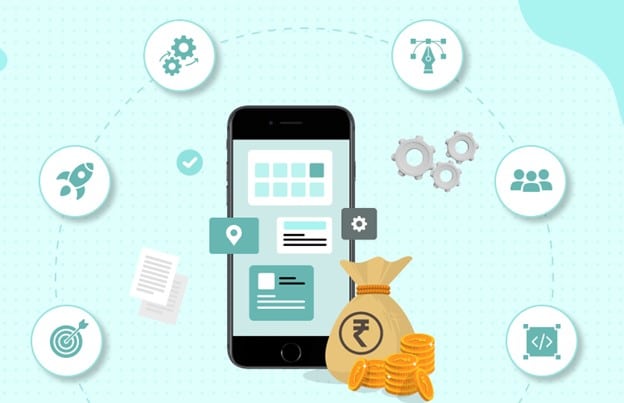
It’s true that professional custom mobile app development is rather pricey. Nevertheless, well-performed planning and the choice of effective approaches and methodologies will save you both time and money with no need to compromise the resulting quality. Below are some recommendations that will help you optimize your budget:
- Set clear objectives and pin down the requirements so that you can minimize the risk of costly reworking later on when the work is in the full swing.
- Decide on the best-matching OS, i.e. whether you’re going to obtain a native, hybrid, or cross-platform solution.
- Opt for Agile-focused developers as they are flexible to make amendments to the aesthetics and UX in the course of the delivery. This has a beneficial effect on the costs as the entire process is exceptionally transparent and you can be sure that you’re paying for the features that you really need. In addition, such companies boast well-established communication within their teams and with the customer, which, no doubt, facilitates your joint efforts to a great extent.
- Outsource the work to offshore vendors that are known for a healthy balance between costs and quality, e.g. those in Central and Eastern Europe.
- Lastly, don’t save on testing and ensure that you employ proficient QA engineers who’ll be able to establish robust processes and verify that your system is functioning as it should end-to-end, according to the specifications and the expectations of end-users. Rely on the feedback from your audience to polish your program and promptly remove any inconsistencies.
To wrap up
The average cost of application development varies significantly and is determined by numerous factors, e.g. the complexity of functions, industry, developers’ location, etc. However, these costs will pay off if you have a well-elaborate business plan in place and involve professionals with a proven track record in mobile app creation. Andersen’s specialists boast well-honed skills in this area and are ever-ready to assist you with implementing ideas of any complexity.